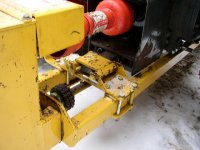Whats a realistic rough percentage of power loss by using hydraulic drive VS direct PTO drive?
The major considerations are:
1. a. Oil volume of tractor if tractor reservoir is used and the tractors useable
total horsepower for hydraulic system.
The tractors hydraulic piping is the major limiting factor as only so
much oil can be delivered and returned to tank to be reused per minute.
and you cannot use a hydraulic motor that requires more oil per minute
than the system can provide without causing component failure from
cavitation.
b. The tractors oil volume and pressure must be capable of the required
flow the hydraulic driven snow blower to operate at speed and snow
disposal volume as claimed by the manufacturer of the appliance.
c. Total useable width of hydraulic drive snow blower (hydraulic drive
impeller with chain drive and open auger for 2 stage unit or closed auger
for a single stage unit it can be wider than wheel set but much slower at work.
2. A tractor with an independent hydraulic sytem and reservoir:
a. limited to hydraulic motors that are capable of recieving the rated flow and pressure at
540 or 1,000 rpm (pumps and motors are tested at 100 psi at 1200 rpm to obtain base
flow measurements only)
pump type
motor type
Gear pumps are the most common and are limited to the hydraulic circuits designed
flow at 1000 or 540 rpm
Geroller motors for the impellers are small and have high speed, a wide power range,
and high torque.
b. PTO powered external pump with quick coupler hydraulic hoses for close by implements
rated for that size of implement.
c. If hydraulic appliance has smaller ports than the hydraulic pressure and return hoses
that is a big problem and a no no because of heat build up pressure surges.
d. The same issues occur with quick couplers due to heat build up.
e. the location of the relief valve if there is one-it HAS TO BE on the pressure side of the
valve controlling the implement where the relief valve is Tee'd back to tank before the
oil enters the valve body and then to the implement.
f. blown motor seals, hoses, or blown pump- you may have a blown motor seal and not
know it until the hydraulics stop working and you see oil in back of the tractor.
3. A rear mounted PTO powered snow blower:
a. PTO shaft with spring slip clutch-ideal installation.
b. The snow blower is recieving the full PTO horsepower at the rated operating speed
required by the implement.
c. Uses the limited hydraulic power available to operate the spout and chute or they are
moved manually by cranks to rotate the spout and locking knobs for the spout tilt angle.
d. Less affected by shock loading from compacted snow and ice due to chain drive and
shear pins on auger and impeller.
e. reverse operation-but going slow allows you to throw the snow far away the first time
and with no build ups.
f. Less affected by wet sloppy snow at all times as full PTO horse power is delivered at all
times.
Like I said I think Pronovost is a better snow blower and they also offer loader mounted hydraulic unit as well.
If you intend on buying it be sure to verify the hoses and quick couplers are sized for the hydraulic ports on the snow blower attachment, and ask where the relief valve is for the independent hydraulic pump and reservoir if you do not see a third hose or relief cartridge in the valve body that controls the snow blower and ask to remove the cover over the pumps suction strainer to see how much crap is in the tank before money changes hands!!!!!!!!!!!!!!!!!!!!
(otherwise walk away)
leonz


